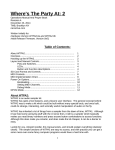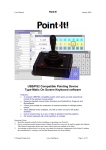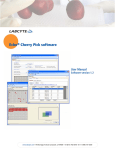Download 1 - CNET Content Solutions
Transcript
VSD231 Smart Display User Guide Model No. VS15715 Compliance Information Please read before proceeding • Use only the batteries and power adapter provided by the manufacturer. The use of unauthorized accessories may void your warranty. • Do not store your device in temperatures higher than 50°C (122°F). • The operating temperature for this device is from 0°C (32°F) to 35°C (95°F). FCC Notice The following statement applies to all products that have received FCC approval. Applicable products bear the FCC logo, and/or contains FCC ID: MCLT77H462 on the product label. This device complies with part 15 of the FCC Rules. Operation is subject to the following two conditions: (1) This device may not cause harmful interference, and (2) This device must accept any interference received, including interference that may cause undesired operation. This mobile device has been tested and found to comply with the limits for a Class B digital device, pursuant to Part 15 of the FCC Rules. These limits are designed to provide reasonable protection against harmful interference in a residential installation. This equipment generates, uses and can radiate radio frequency energy and, if not installed and used in accordance with the instructions, may cause harmful interferenceto radio communications. However, there is no guarantee that interference will not occur in a particular installation. If this equipment does cause harmful interference to radio or television reception, which can be determined by turning the equipment off and on, the user is encouraged to try to correct the interference by one or more of the following measures: •Reorient or relocate the receiving antenna. •Increase the separation between the equipment and receiver. •Connect the equipment into an outlet on a circuit different from that to which the receiver is connected. •Consult the dealer or an experienced radio/TV technician for help. Any changes or modifications not expressly approved by the party responsible for compliance could void the user’s authority to operate the equipment. This transmitter must not be co-located or operating in conjunction with any other antenna or transmitter. FCC SAR Information This equipment complies with FCC radiation exposure limits set forth for an uncontrolled environment. End users must follow the specific operating instructions for satisfying RF exposure compliance. This equipment should be installed and operated with a minimum distance of 20 centimeters between the radiator and your body. The users manual or instruction manual for an intentional or unintentional radiator shall caution the user that changes or modifications not expressly approved by the party responsible for compliance could void the user's authority to operate the equipment. i Canada Statement This device complies with Industry Canada licence-exempt RSS standard(s). Operation is subject to the following two conditions: (1) this device may not cause interference, and (2) this device must accept any interference, including interference that may cause undesired operation of the device. Caution: Exposure to Radio Frequency Radiation To comply with RSS 102 RF exposure compliance requirements, a separation distance of at least 20 cm must be maintained between the antenna of this device and all persons. Pour se conformer aux exigences de conformité CNR 102 RF exposition, une distance de séparation d'au moins 20 cm doit être maintenue entre l'antenne de cet appareil et toutes les personnes. Following information is only for EU-member states: The mark shown to the right is in compliance with the Waste Electrical and Electronic Equipment Directive 2012/19/EU (WEEE). The mark indicates the requirement NOT to dispose the equipment as unsorted municipal waste, but use the return and collection systems according to local law. If the batteries, accumulators and button cells included with this equipment, display the chemical symbol Hg, Cd, or Pb, then it means that the battery has a heavy metal content of more than 0.0005% Mercury, or more than 0.002% Cadmium, or more than 0.004% Lead. ii ENERGY STAR This ENERGY STAR qualified product saves your money by reducing energy cost and protecting the environment without sacrificing features or performance. We are proud to offer our customers products with the ENERGY STAR mark. What is ENERGY STAR? Products that are ENERGY STAR qualified use less energy and prevent greenhouse gas emissions by meeting strict energy efficiency guidelines set by the U.S. Environmental Protection Agency. We commit to offering products and services worldwide that help customers save money, conserve energy and improve the quality of our environment. The more energy we can save through higher energy efficiency, the more we reduce greenhouse gases and the risks of climate change. More information refers to www. energystar.gov or ww.energystar.gov/powermanagement. Note: Information in this section may not apply to your computer. This ENERGY STAR qualified product: - produces less heat and reduce cooling loads in warmer climates. - automatically goes into "display Sleep" and "computer Sleep" mode after 10 minutes of inactivity. - wakes from "Sleep" mode by pressing the power button. - saves more than 80% energy when in "Sleep" mode. ENERGY STAR and the ENERGY STAR mark are registered U.S. marks. iii Declaration of RoHS2 Compliance This product has been designed and manufactured in compliance with Directive 2011/65/ EU of the European Parliament and the Council on restriction of the use of certain hazardous substances in electrical and electronic equipment (RoHS2 Directive) and is deemed to comply with the maximum concentration values issued by the European Technical Adaptation Committee (TAC) as shown below: Substance Lead (Pb) Mercury (Hg) Cadmium (Cd) Hexavalent Chromium (Cr6+) Polybrominated biphenyls (PBB) Polybrominated diphenyl ethers (PBDE) Proposed Maximum Concentration 0.1% 0.1% 0.01% 0.1% 0.1% 0.1% Actual Concentration < 0.1% < 0.1% < 0.01% < 0.1% < 0.1% < 0.1% Certain components of products as stated above are exempted under the Annex III of the RoHS2 Directives as noted below: Examples of exempted components are: 1.Mercury in cold cathode fluorescent lamps and external electrode fluorescent lamps (CCFL and EEFL) for special purposes not exceeding (per lamp): (1) Short length (≦500 mm): maximum 3.5 mg per lamp. (2) Medium length (>500 mm and ≦1,500 mm): maximum 5 mg per lamp. (3) Long length (>1,500 mm): maximum 13 mg per lamp. 2.Lead in glass of cathode ray tubes. 3.Lead in glass of fluorescent tubes not exceeding 0.2% by weight. 4.Lead as an alloying element in aluminium containing up to 0.4% lead by weight. 5.Copper alloy containing up to 4% lead by weight. 6.Lead in high melting temperature type solders (i.e. lead-based alloys containing 85% by weight or more lead). 7.Electrical and electronic components containing lead in a glass or ceramic other than dielectric ceramic in capacitors, e.g. piezoelectric devices, or in a glass or ceramic matrix compound. iv Important Safety Instructions 1. DO NOT place objects on top of the device, as objects may scratch the screen. 2. DO NOT expose the device to dirty or dusty environments. 3. DO NOT place the device on an uneven or unstable surface. 4. DO NOT insert any foreign objects into the device. 5. DO NOT expose the device to strong magnetic or electrical field. 6. DO NOT expose the device to direct sunlight as it can damage the LCD Screen. Keep it away from heat sources. 7. DO NOT use the device in the rain. 8. Please check with your Local Authority or retailer for proper disposal of electronic products. 9. The device and the adapter may produce some heat during normal operation or charging. To prevent discomfort or injury from heat exposure, DO NOT leave the device on your lap. 10. POWER INPUT RATING: Refer to the rating label on the device and be sure that the power adapter complies with the rating. Only use accessories specified by the manufacturer. 11. DO NOT use a pen or any sharp object to tap the screen. 12. Clean the touch screen with a soft cloth. If needed, dampen the cloth slightly before cleaning. Never use abrasives or cleaning solutions. 13. Always power off the device to install or remove external devices that do not support hot-plug. 14. Disconnect the device from an electrical outlet and power off before cleaning the device. 15. DO NOT disassemble the device. Only a certified service technician should perform repair. 16. The device has apertures to disperse heat. DO NOT block the device ventilation, the device may become hot and malfunction as a result. 17. Users have to use the connection to USB interfaces with USB 2.0 version or higher. 18. PLUGGABLE EQUIPMENT: the socket-outlet shall be installed near the equipment and shall be easily accessible. v Copyright Information Copyright © ViewSonic Corporation, 2014. All rights reserved. Android™ is a trademark of Google Inc. Use of this trademark is subject to Google Permissions. This product has an Android™ platform based on Linux, which can be expanded by a variety of JME-based application SW. All products used in this device and trademarks mentioned herein are trademarks or registered trademarks of their respective owners. Google™, the Google logo, Android™, the Android logo and Gmail™ are trademarks of Google Inc. Use of this trademark is subject to Google Permissions. Wi-Fi and the Wi-Fi CERTIFIED logo are registered trademarks of the Wireless Fidelity Alliance. microSD™ is a trademark of SD Card Association. Java, JME and all other Java-based marks are trademarks or registered trademarks of Sun Microsystems, Inc. in the United States and other countries. The actual included applications (apps) may differ from the illustrated screen shots. VESA® is a registered trademark of the Video Electronics Standards Association. DPMS and DDC are trademarks of VESA®. ENERGY STAR® is a registered trademark of the U.S. Environmental Protection Agency (EPA). As an ENERGY STAR® partner, ViewSonic Corporation has determined that this product meets the ENERGY STAR® guidelines for energy efficiency. Disclaimer: ViewSonic Corporation shall not be liable for technical or editorial errors or omissions contained herein; nor for incidental or consequential damages resulting from furnishing this material, or the performance or use of this product.In the interest of continuing product improvement, ViewSonic Corporation reserves the right to change product specifications without notice. Information in this document may change without notice. No part of this document may be copied, reproduced, or transmitted by any means, for any purpose without prior written permission from ViewSonic Corporation. Intellectual Property Right Information Right to all technologies and products that comprise this device are the property of their respective owners: This product has an Android platform based on Linux, which can be expanded by a variety of Java-Script-based application SW. Google, the Google logo, Android, the Android logo, Gmail, and YouTube are trademarks of Google Inc. Java, JME and all other Java-based marks are trademarks or registered trademarks of Sun Microsystems, Inc. in the United States and other countries.microSD is a trademark of SD Card Association. vi Product Registration To meet your future needs, and to receive any additional product information as it becomes available, please register your product on the Internet at: www.viewsonic.com. For Your Records Product Name: Model Number: Document Number: Serial Number: Purchase Date: VSD231 ViewSonic Smart Display VS15715 VSD231_UG_ENG Rev. 1A 06-16-14 _______________________________ _______________________________ Product disposal at end of product life ViewSonic respects the environment and is committed to working and living green. Thank you for being part of Smarter, Greener Computing. Please visit ViewSonic website to learn more. USA & Canada: http://www.viewsonic.com/company/green/recycle-program/ Europe: http://www.viewsoniceurope.com/uk/support/recycling-information/ Taiwan: http://recycle.epa.gov.tw/recycle/index2.aspx vii Table of Contents Table of Contents 1VSD231 Smart Display Features 2Set Up Your VSD231 Smart Display 2.1 2.2 2.3 2.4 Connection.......................................................................... 4 Get Your Smart Display Ready for Use............................... 4 Power on Your Device......................................................... 5 Power Off Your Device........................................................ 6 3About Your VSD231 Smart Display 3.1 3.2 3.3 3.4 3.5 Touch Screen...................................................................... 7 Applications, Widgets and Shortcuts................................... 8 Home Screen...................................................................... 8 Navigation buttons............................................................. 10 Status Bar...........................................................................11 3.5.1Managing Status Menu..........................................11 3.6 Customizing Your Home Screen....................................... 12 3.6.1Add an Item (Shortcut)......................................... 12 3.6.2 Move an Item ...................................................... 12 3.6.3Delete an Item ..................................................... 12 3.6.4Change the Wallpaper ......................................... 12 3.7 Navigating the Applications............................................... 13 3.7.1Apps screen.......................................................... 13 3.7.2Application Shortcuts............................................ 13 3.7.3Recent Applications.............................................. 14 3.7.4Screen Lock Wallpaper......................................... 14 4Using Your VSD231 Smart Display 4.1 Managing Contacts........................................................... 15 4.1.1Add a new contact................................................ 15 4.1.2Choose a contact.................................................. 15 4.1.3E-mail or send a message to a contact................ 16 4.2 Pop-up Menu..................................................................... 18 4.3 Google Search.................................................................. 19 4.4 Managing Your Device Settings........................................ 20 4.4.1Check storage spaces.......................................... 20 viii Table of Contents 4.4.2Remove the SD card safely.................................. 21 4.4.3Erase all data from your device............................ 21 4.5 Devices Connection.......................................................... 22 4.5.1Connecting to HDMI-compliant Devices via HDMI/MHL Input................................................... 22 4.5.2Connecting to VGA Input...................................... 23 4.5.3Connecting to HDMI-compliant Devices via HDMI Output......................................................... 23 4.6 Screen Mirroring................................................................ 24 5Internet 5.1 Connecting to the Internet................................................. 25 5.1.1Wi-Fi connection................................................... 25 5.1.2Check the current Wi-Fi network connection........ 26 5.1.3Connect to another Wi-Fi network........................ 26 5.2 Synchronizing Your Google Data...................................... 27 5.3 Video Chat......................................................................... 27 6Customizing Your VSD231 Smart Display 6.1 Display Settings................................................................. 29 6.2 Sound Settings.................................................................. 30 6.2.1Sound setting........................................................ 30 6.2.2System settings.................................................... 31 6.3 Date, Time, and Time Zone............................................... 31 6.4 Language & Input Settings................................................ 33 6.5 OSD Menu......................................................................... 33 6.5.1Adjustment Bars................................................... 34 6.5.2Functions items.................................................... 34 6.5.3OSD Notice........................................................... 35 6.5.4OSD and Hot keys setting.................................... 36 7Protecting Your VSD231 Smart Display 7.1 Protect Your Device Data with a Screen Unlock Pattern... 37 7.1.1Create a screen unlock pattern............................ 38 7.1.2Change unlock pattern settings............................ 38 7.2 Disable the screen unlock security.................................... 39 7.3 Protect Your Device Data with a PIN................................. 39 7.3.1Disable or change PIN.......................................... 39 7.4 Protect Your Device Data with a Password....................... 40 7.4.1Disable or change the password.......................... 40 ix Table of Contents 7.5 Protect Your Device Data with Face Unlock........................ 41 7.6 Power Saving Feature....................................................... 42 7.7 Power Management Information....................................... 42 8Troubleshooting 8.1 Touch Screen Problems.................................................... 43 8.2 Messaging Problems......................................................... 43 8.3 Other Problems................................................................. 44 9Appendix Specification.............................................................................. 45 x VSD231 Smart Display Features VSD231 is a Smart Display with 23-inch quad-core display running on Android 4.3 Jelly Bean. Comes with 1920x1080p HD multi-touch resolution, allow you to work with HDMI via MHL, full-sized USB connectivity as well. 1VSD231 Smart Display Features This section introduces you to the features of your Smart Display. NOTE • The features or applications described in this User’s manual may vary depended on the device model purchased. Front View 2 1 2 3 4 5 6 7 8 9 No. Components 1 Front-Panel Camera 2 Microphone 3 Touch Screen Descriptions - Used for taking a front picture just the same as a self-portrait. - Used for making video calls with supportive web applications, such as Hangouts. Used for receiving audio or audio input. Touch the screen to control the on-screen configurations including menu items, applications, buttons, keyboard and so on. 1 VSD231 Smart Display Features No. Components 4 Input Signal Switch / OSD Menu Select 5 6 Arrow Button (Up / Right) Arrow Button (Down / Left) 7 OSD Menu / Exit 8 Power button 9 LED indicator Descriptions - Touch to switch input signal (Android / HDMI IN / D-Sub). - Select function in OSD menu. Use the arrow buttons (Up / Right and Down / Left) to move through OSD menus. You can highlight a menu item by touching the arrow buttons. You can also use the arrow buttons to adjust the values to each item of OSD menu. Touch this button to launch the OSD configuration menu and touch again to exit. Touch to power on / lock the smart display. - Touch about 0.5 seconds to power on the power. - Lock the smart display when the display is on. - Recall the unlock display when the smart display is locked. - When the display is on, press this button and hold for about 3 seconds to shut down the smart display (under Android mode). - LED in blue when power on. - LED turns into amber when smart display be locked. 2 VSD231 Smart Display Features Back View 1 2 3 4 5 6 7 8 No. Components 9 10 11 12 Descriptions Connect to windows computer for data transferring. (Need MTP driver) Input SD card to extend storage capacity. (Up to 32 GB) Used for keyboard, mouse, flash disk ( supports FAT32 format only) or printer connections. 1 Micro USB Port 2 SD Card Slot 3 USB Ports 2.0 4 USB Ports 3.0 x3 5 RJ45 Connector Connect to a RJ45 cable for network connection. 6 USB B-Type Port 7 HDMI OUT (output) 8 HDMI IN (MHL) 9 D-Sub External display mode for USB upstream, Webcam and Touch-screen control functionality. Connect to digital high quality device for video and audio configurations (e.g. DVD Player, BD Player VPG or Notebook). Video input from external device. 10 DC in Port Connect to power adaptor. 11 Audio in Audio input from external device. 12 Earphone Jack Connect to earphone or headset. 3 Set Up Your VSD231 Smart Display 2 Set Up Your VSD231 Smart Display 2.1Connection Micro USB External Computer SD USB SD card USB Earphone Audio in Power D-Sub HDMI IN HDMI OUT (MHL) (output) USB B-Type LAN USB USB Keyboard Printer Mouse USB Storage Earphone DVD Player DVD Player Outlet Monitor Notebook Notebook External Computer Smart Phone 2.2 Get Your Smart Display Ready for Use Insert the SD card 1 Insert a SD card if desired and / or available on the back of your smart display. 4 Wi-Fi Devices Set Up Your VSD231 Smart Display Connect the Power Cord 1 Connect the included power cord to the power jack. 2 Connect the other end of the power cord to a suitable power outlet. 2.3 Power on Your Device Touch the power button gently to power on your device Slide the lock icon to unlock the screen (if the lock screen function with slide is enabled) 1 After connecting the power cord, you can touch the power button about 0.5 seconds to power on your device. 2 3 Once powered-up, the LED indicator will show solid Blue. 4 5 Touch and slide the lock icon to unlock the screen if necessary. The unlock display will appear after a short boot-up period. (If the lock screen function is enabled). The device is ready for use when the Home screen is displayed. 5 Set Up Your VSD231 Smart Display 2.4 Power Off Your Device 1 2 Touch and hold the power button for about 3 seconds. When the power off menu appears, touch OK. 6 About Your VSD231 Smart Display 3About Your VSD231 Smart Display 3.1 Touch Screen The main way to control the device is using your finger to touch the sensitive surface of the screen directly. You can manipulate icons, buttons, menu items, on-screen keyboard and other items on the touch screen with below methods: Methods Touch Touch and Hold Drag Swipe or Slide Zoom Out Zoom In Descriptions Simply touch the items with you finger. - Act on items on the screen including application and settings icons. - Type letters and symbols using the on-screen keyboard. - Press the on-screen buttons. Touch and hold an item on the screen by touching it without lifting your finger until an action occurs. Touch and hold an item then move the item with your finger until reaching the target position. - Move an item on the screen. - Scroll through Home screens, web pages, lists, entries, photo thumbnails, contacts and so on. Quickly move your finger across the surface of the screen without pausing when you first touch it. Move two fingers close together on the screen to reduce the view of an image or web page. Move two fingers apart on the screen to enlarge the view of an image or web page. NOTE • You can connect the dots three to zoom the entire display frequency, also with two fingers to rotate and zoom the display for ex. Google map, as well as voice output designed specifically for blind users and gesture mode navigation features. 7 About Your VSD231 Smart Display 3.2 Applications, Widgets and Shortcuts The soft buttons or icons offer a variety of functions and shortcuts. On the Home screen, it is your starting point to access all the features on your device. It displays application icons, widgets, shortcuts and so on. Applications: Software allows you to perform a specific task. Power on your device, it is preloaded with a variety of applications already. You can also download additional applications from the Google Play Store. Widgets: Widgets are applications that you can use directly on the Home screen. Example: Analog clock, Bookmark, Picture frame, the Google search bar and so on. Shortcuts: A link that you can create on your Home screen to provide quicker access to applications you have installed. 3.3 Home Screen Once you power on your device, and unlock your screen, the central Home screen will display firstly. You can also touch the Home button to go to Home screen. On the Home screen, it allows you to access all the features installed in your device. The Home screen is composed of five screen panels. You can slide your finger to left or right across the central Home screen to view more widgets, shortcuts, and other items located on each screen panel. You can also add shortcuts, widgets or change the desktop wallpaper on each screen panel. 8 About Your VSD231 Smart Display 12 11 10 1 9 8 2 7 3 No. 4 5 6 Items Descriptions Google Search Navigation Area Use the Google Search application to search the web faster and easier from Google. 3 Back Return to the previous screen or option. 4 Home 5 Recent Applications 6 Screehshot 7 Apps 1 Google 2 8 9 10 12:17 Flick and drag the screen horizontally until the desired Home screen is displayed. This button will indicate you to go back to central Home screen at any time. Touch this button to show you a list of images about the applications you have accessed recently. You can touch the listed image to open the applications. Tap this button to capture an image of your screen. Touch the Apps button to launch all of the applications installed on your device. Widgets Widgets are small applications that reside on the Home screen to provide quick access to information. Wi-fi The Wi-fi icon will appear on the upper right corner of the screen when you enable the Wi-fi function. Time Display the current time. 9 About Your VSD231 Smart Display No. Items 11 Voice Input 12 Shortcuts Descriptions Use voice input as an alternative to text entry via keyboard. You can add an application shortcut to the Home screen and move it freely by touching and holding the specified icon. This icon allows you to open a shortcut item quickly. 3.4 Navigation buttons On the bottom of the screen (system bar), you can find the navigation buttons described as below: Buttons Descriptions Back - Touch this button to go back to the previous screen or option. - If the on-screen keyboard is displayed, the button changes to . Touch it to close the on-screen keyboard. Home - Touch this button to go to the central Home screen when viewing other Home screens. - Touch this button to go back to the last Home screen you have viewed when launching any functions on the device. Or touch this button again to go back to central Home screen. Recent Apps. A short-cut way for you to open recent application you have accessed. Select and touch one of the images from the list to open the application directly. Screehshot Tap this button to capture an image of your screen. 10 About Your VSD231 Smart Display 3.5 Status Bar The upper right corner of the screen displays current time, and specified icon (status bar). Items Time Descriptions Displays the current time. Specified Icon Show you the enabled icon. Status Menu Show you the current state of your device just like Owner, Brightness, Settings, and WIFI Settings. 3.5.1 Managing Status Menu You can touch and drag down the Time area on the status bar to appear the status menu. • Touch OWNER item to view people saved on your system. • Touch BRIGHTNESS item to adjust light level. • Touch SETTINGS item to enter Settings menu that allows you to change the display settings. For more information, please Refer to 6 Customizing Your VSD231 Smart Display. • Touch WI-FI item to enter WIRELESS & NETWORKS configuration menu that allows you to enable/disable and configure Wi-Fi function. Touch any other area of the screen to close the Status Menu. 11 About Your VSD231 Smart Display 3.6 Customizing Your Home Screen 3.6.1 Add an Item (Shortcut) • Touch the Home button to go back the central Home screen. • Drag on the screen horizontally to select a Home screen where you want to add the item. • Touch the Apps button located on the bottom of your screen. • On the Apps screen, touch APPS or WIDGETS tab to enter APPS or WIDGETS configuration screen. • Select one of APPS or WIDGETS item that you want to add. • Touch and hold the item to add it onto the selected Home screen. 3.6.2 Move an Item • On the Home screen, touch and hold the item that you want to move. • Move the item to the specified position. • Then release your finger to add the item to the new position. 3.6.3 Delete an Item • On the Home screen, touch and hold the item that you want to delete such as a widget or shortcut. • An “X Remove” will soon be displayed at the top of the Home screen. • Drag the item over the “X Remove”. • Then release your finger to delete the item. 3.6.4 Change the Wallpaper • Long Touch (touch and hold) an empty space on the screen. • A “Choose wallpaper from” configuration screen will appear. • Select one of the wallpaper sources by touching the specified icon. (Wallpaper sources: ES File Explorer, Gallery, Live Wallpapers and Wallpapers) • Tap on the desired wallpaper image. You can always exit by tapping . • Once finishing the wallpaper selection, touch “Set wallpaper” to renew the wallpaper of Home screen. 12 About Your VSD231 Smart Display • Some wallpaper allows you to change the wallpaper color, ex. Magic Smoke. If “Settings…” displays during the changing wallpaper. Touch it , and on the top of screen will display “Tap to change”, touch the screen to configure the wallpaper color. Tap the screen to cycle through the different colors. • You can touch Back button to go back previous screen without renew any changed settings. NOTE • All Home Screens share the same background. You cannot set different wallpapers to individual Home Screen panel. 3.7 Navigating the Applications You can find applications available on your device in the all Apps menu: 3.7.1 Apps screen Open the Apps screen You can access Apps screen from any Home screen by touching the Apps button located on the bottom of your screen. The Apps screen contains all of the applications installed on the device including those you have downloaded. Navigate pages of applications Flick the Apps screen horizontally and touch an application to launch it. Close the Apps Screen Touch the Home button on the system bar to go back the central Home screen. 3.7.2 Application Shortcuts To quickly launch applications on the Home screen, you can add shortcuts for frequentlyused application to the Home screen. For more information, please Refer to 3.6 Customizing Your Home Screen. 13 About Your VSD231 Smart Display Use the shortcut to open an application 1 2 Touch the Home button on the system bar. If the desired application shortcut displays on the Home screen, touch the shortcut to launch the application. 3.7.3 Recent Applications Open a recently used application 1 Touch the Recent Applications button to view the recently used applications. 2 Scroll the list of recently used applications, and touch the desired application thumbnail to launch the application. 3 Touch the Recent Applications button recently used applications. again to close the list of 3.7.4 Screen Lock Wallpaper You can set the display to turn off automatically after a timeout period of inactivity, or power it off manually by touching Power button. When you touch the Power button to wake up the display, the screen lock wallpaper appears to avoid unintentional touch of the screen. When the screen lock wallpaper appears, touch and hold the lock icon, drag it to the edge of the larger circle that surrounds it to unlock the screen. Refer to 2.3 Turn On Your Device. NOTE • Set the duration of screen to remain on before entering sleeping mode, touch the Home button│Apps button│Settings│Display│Sleep. 14 Using Your VSD231 Smart Display 4Using Your VSD231 Smart Display 4.1 Managing Contacts Touch Home button│Apps button│Settings│ACCOUNTS. 4.1.1 Add a new contact 1 2 Touch + Add account. Select the account where you want to add this contact, such as your Google account. This area shows the account in which the new contact is stored. Follow the on screen instruction to create your contact. NOTE • VSD231 supports you fully customized tablet with multiple users. Each person has their own Home screen, background, widgets, apps, games and so on. Multiple users can use one table to talk simultaneously without having to log in and out. 4.1.2 Choose a contact 1 2 To locate a contact, you can either: • Drag the scroll bar to scroll through the contacts list. • Touch Find contacts, and type either the contact’s full name or only the first letters of it into the text box. The screen displays the matching contacts. Once the contact is located, touch the contact’s entry to view the contact’s details. 15 Using Your VSD231 Smart Display 4.1.3 E-mail or send a message to a contact 1 2 On the contacts list, find a desired contact. Touch the contact entry to view the contact details, and then touch to send e-mail using the e-mail accounts you have set up on your device, or touch it to send a message. Edit a contact 1 2 3 4 On the contacts list, find a desired contact. Touch the contact entry to view the contact details. Touch to edit the contact details. Touch Done to save the changes. Share a contact 1 2 3 4 On the contacts list, find a desired contact. Touch the contact entry to view the contact details. Touch the Menu button on the upper right of screen, then select Share contact. From the Share contact via menu that appears, select the way you want to share the contact information with your friends, such as through Gmail. NOTE • Upcoming Gmail app for Android 4.3 brings pinch-to-zoom and swipe to delete. These let you to pinch-to-zoom the Gmail app and swipe to archive/delete the message automatically; you can change the system settings to configure the app for one method or the other. 16 Using Your VSD231 Smart Display Join contacts Since your device can synchronize with a variety of accounts, when synchronizing contacts from these accounts with your device, you may have multiple contacts for the same person. Joining contacts allows you to view all the contact’s numbers, addresses, and so on, in one single contact entry. 1 2 3 4 On the Contacts list, find a desired contact. Touch the contact entry to view the contact details, and then touch Edit on the upper right of the screen. Then, touch the Menu button on the upper right of the screen│Join. From the Join contacts list, touch another contact to link, and then touch Done. The joined contact’s information is displayed with the original Contacts settings. 17 Using Your VSD231 Smart Display In People, touch the Menu button on the device or the Menu button on the screen. Settings Accounts NOTE: If you want to synchronize individual data manually, clear Autosync, and then from your account, touch a data item to start synchronization of that data. While data is syncing, the sync icon appears on the option of the data being synced. Import/Export Descriptions Contacts stored on your device can be synchronized with a computer using Mobile Sync; contacts stored on your personal e-mail account such as Gmail can be synchronized through an Internet connection. • To select the data to synchronize: 1. Select Background data to make all the sync options available. 2. Select Auto-sync to let the device automatically synchronize the selected data in your Twitter account or e-mail account, which may include Twitter contacts and data, or Calendar, Contacts, Gmail, and Picasa WebAlbums data. • To select the data to sync from your e-mail account: 1. Touch your e-mail account to open the Data & synchronization list. 2. Select the data that you want the device to synchronize automatically, such as Sync Calendar, Sync Contacts, Sync Gmail, Sync Picasa Web Albums. You can import contacts from your SD card to your device, export Contacts from your device to your SD card, and share visible contacts in multiple ways, such as Gmail. 4.2 Pop-up Menu Touch the Menu button on the screen to open the pop-up menu that lists available options for the current application, or actions that you can perform on the current screen. Select an option or item on the pop-up menu 1 2 Touch the Menu button on the screen to open the pop-up menu. Touch the desired item on the pop-up menu. 18 Using Your VSD231 Smart Display 4.3 Google Search You can use the Google Search widget to find websites and information on Google, applications installed on your device, contacts stored in your Contacts list and sourced from Gmail log in. For Android 4.3 Jelly Bean, Google Now is also made more handy-dandy with the inclusion of cards containing flight information, restaurant reservations, hotel confirmations, and shipping details. You will also find Google Field Trip-esque cards identifying nearby movie times, attractions, photogenic locales, and concerts by your favorite artists. Search by typing 1 2 3 4 5 From the Google Search widget on the Home screen, touch “Google” to open the Google Search widget below. Type a keyword or text into the box using the keyboard. As you type, the search results that fully or partially match the text being typed appear. Scroll the listed search results and touch the desired result. The matching application or the browser with matching web links opens. Touch the desired link if you want to view a web page. 19 Using Your VSD231 Smart Display Search by voice 1 2 3 Touch the microphone that appears beside the search box. Say the name or keyword of the item you want to search. The browser with matching web links opens. 4.4 Managing Your Device Settings 4.4.1 Check storage spaces Touch the Home button │ Apps button │ Settings │ Storage. The screen displays the total and available space on the device, USB storage and SD card. Erase unwanted application data 1 2 3 Touch the Home button │ Apps button │ Settings │ Apps. Touch the application whose cache or data you want to remove. Touch Clear data under Storage to erase unwanted application data; touch Clear cache under Cache to erase unwanted cache. 20 Using Your VSD231 Smart Display 4.4.2 Remove the SD card safely 1 2 3 4 Touch the Home button │ Apps button │ Settings │ Storage. Touch Unmount SD card under the SD Card section. Press and hold the Power button until the Power off menu appears. Then, touch OK to turn off the device. Remove the SD card from your device. NOTE • Removing the SD card while the device is working may cause data loss or result in -application errors. We suggest you unmount the SD card before removing it. 4.4.3 Erase all data from your device 1 2 3 Touch the Home button │ Apps button │ Settings │ Backup & reset. Touch Factory data reset tablet. Touch “Reset smart display” to erase everything after you read the warning. NOTE • Ensure that you have back up all the required data before erasing all data from your device. 21 Using Your VSD231 Smart Display 4.5 Devices Connection 4.5.1 Connecting to HDMI-compliant Devices via HDMI/MHL Input HDMI (High-Definition Multimedia Interface) and MHL (Mobile High-Definition Link) are compact audio/video interfaces for transferring uncompressed digital audio/video data. You can obtain the best user experience for video playback and gaming via these inputs. VSD231 is equipped with a HDMI input for connection to an external HDMI or MHL compliant devices. You can connect your PC, notebook, Blu-ray player or any other HDMI / MHL compliant devices to VSD231 for high-definition video display. How to begin 1 2 3 A “type A (HDMI) to type A (HDMI)” HDMI cable or “MHL to type A (HDMI)” cable must be available. 4 5 For PC or notebook connection, always set the appropriate resolution. VSD231 supports with max. resolution of 1920*1080. Connect the Type A HDMI connector or MHL connector of the cable to the desired HDMI / MHL compliant device. Connect the Type A connector of the HDMI cable to the HDMI port located on the back of your VSD231. to choose the 1) P ress the SELECT key input source on the OSD window. 2) U se UP ▲ and DOWN ▼ keys to select the source. again to Enter 3) P ress the SELECT key to exit. or press MENU Note: 1) The INPUT SELECT OSD window will close after 15 sec. without any action. 2) If there is no signal source, press SELECT to choose another source. key To enable the Webcam, USB upstream and touch screen function, connect the USB cable to USB B-type connector of VSD231 and connect the other end to your PC or notebook. NOTE • The touch screen function will work with computers running Windows 7 or later versions without the need for additional drivers. • When in display mode, the VSD231 Smart Display will temporarily display “No Signal” and then switch back to Android OS when PC enters sleep mode. 22 Using Your VSD231 Smart Display 4.5.2 Connecting to VGA Input The detachable signal cable of the monitor shall be black. The video cable shall be high quality, shielded, which has a molded-over, triple row, 15 position, and subminiature D connector. The connector over-mold shall be blue in color with the WHQL monitor symbol molded into the over-mold. The connector shall have captive screw locks, which will be adequate for hand tightening. Slots for tightening of the screw locks using a screwdriver shall not be supported. How to begin 1 Connect the VGA connector of the VGA cable to the desired VGA compliant device. Connect the Stereo mini 3.5 mm plug Audio cable to the device. 2 Connect the VGA connector of the VGA cable to the VGA port located on the back of your VSD231. to choose the 1) Press the SELECT key input source on the OSD window. 2) U se UP ▲ and DOWN ▼ keys to select the source. 3) P ress the SELECT key again to Enter or press MENU to exit. Note: 1) The INPUT SELECT OSD window will close after 15 sec. without any action. 2) If there is no signal source, press SELECT key to choose another source. 4.5.3 Connecting to HDMI-compliant Devices via HDMI Output The HDMI signal output connector on the monitor shall be 19 contact HDMI receptacle capable of transmitting HDMI TMDS digital video. The HDMI cable shall be constructed with the HDMI connector on both ends. The cable end shall have molded-over HDMI male connector; the connector overmold shall be black in color, and the HDMI symbol molded into the overmold. All HDMI cable assemblies shall meet all requirements of the High Definition Multimedia Interface specification. All HDMI cables shall be tested and certified to the supported HDMI specification (1.3 or 1.4). For monitors with resolutions of 1080P 60Hz , the HDMI cable shall be certified as a “High Speed” cable. NOTE • The HDMI display used for HDMI out function needs to have at least 1920 x 1080 resolution. 23 Using Your VSD231 Smart Display 4.6 Screen Mirroring Screen Mirroring is a peer-to-peer wireless screencast technology that allows your device to connect with each other wirelessly. VSD231 can act as the sending device to deliver audio and video wirelessly. How to begin 1 Touch the Home button │ Apps button │Settings │ Wi-Fi to enable Wi-Fi function by touching “ON”. 2 Touch Screen Mirroring and select a display which you want to connect to. 3 4 Select “Connect using the WPS button“ or “Connect using a password or PIN” to fit the setting on the device which you connect to. Press the Wi-Fi Protected Setup button on your display or adapter. Then, You can successfully share audio and video to other device on the same time. 24 Internet 5Internet 5.1 Connecting to the Internet To browse the web and access web-based utilities such as instant messaging, you can connect VSD231 to a LAN network via RJ45 cable on LAN connector or set up a Wi-Fi connection. 5.1.1 Wi-Fi connection 1 2 Touch the Home button │ Apps button │Settings │ Wi-Fi to enable WiFi function by touching “ON”. The device scans for available wireless networks. Touch Wi-Fi settings. The network names and security settings (Open network or Secured with WEP/WPA/WPA2/WPS) of discovered Wi-Fi networks display in the Wi-Fi networks list. 3 Flick the list and touch to select a Wi-Fi network you want to connect to. 4 Enter a password (if necessary), then touch Connect to connect to the Wi-Fi network. Connect to a network protected by Wired Equivalent Privacy (WEP), Wi-Fi Protected Access (WPA), WPA2, or Wireless Protected Setup (WPS), you must enter the WEP/WPA/WPA2/WPS security key to obtain authorized access to the network. The next time your device connects to a previously accessed secured wireless network, you will not be required to enter the WEP/WPA/WPA2/WPS key again, unless you reset your device to its factory default settings. 25 Internet 5.1.2 Check the current Wi-Fi network connection From the status area of the system bar: When your device is connected to a wireless network, the Wi-Fi icon in the status area of the system bar indicates the signal strength (number of bands that light up). If Settings│ Wi-Fi│ Network notification is enabled, the “?” icon appears in the notifications area of the system bar, as the device discovers an accessible Wi-Fi network within range. From the Wi-Fi network: 1 2 3 Touch the Home button │ Apps button │ Settings │ Wi-Fi. Touch the Wi-Fi network that the device is currently connected to (labeled Connected). A screen opens displaying the Wi-Fi network’s name, status, security information, signal strength, link speed, and IP address. If you want to disconnect the Wi-Fi network from your device, touch Forget on this screen. You will need to configure the Wi-Fi settings again if you want to restore connection to this wireless network. 5.1.3 Connect to another Wi-Fi network 1 Touch the Home button │ Apps button │ Settings │ Wi-Fi. The detected Wi-Fi networks are displayed in the Wi-Fi networks list. 2 Start a new search for available Wi-Fi networks, on the Wi-Fi settings screen, touch the Menu button on the upper right of screen │ Scan. 3 Flick through the Wi-Fi networks list and touch the name of the network you want to connect to. 4 If the wireless network you want to connect to is not on the list, tap the “+” sign on the upper right-hand side to add your Wi-Fi network. Enter the Wi-Fi network settings, and then touch Save. 26 Internet 5.2 Synchronizing Your Google Data Through a web connection, your device can synchronize your Google data including Gmail, calendar, and contacts with your computer or any other device that you use to access your Google account. Select the applications to synchronize 1 2 3 Touch the Home button │ Apps button │ Settings │ ACCOUNTS In the ACCOUNTS section, tap the icon to check the box to enable all the sync options. This includes Sync Calendar, Sync Contacts, Sync Gmail and Sync Picasa Web Albums. If you want to add an account to be synchronized, tap on “+ Add Account” on the left of the screen under the account you want to synchronize. NOTE • While data is syncing, the sync icon appears on the option of the data being synced. 5.3 Video Chat Equipping with a front webcam and a microphone, VSD231 allows communication with other users on the Internet. VSD231 supports various video chat apps from Google Play. By default, Hangouts is the most simple video chat application for Android devices and pre-installed already. Here’s a short list of what you will need to use the video chat function of Hangouts: • VSD231 • Google Account • People to chat with (who also have a Google account and have been added into your Hangouts friend list) 27 Internet How to begin 1 2 3 Authenticate your Google account You can do this by opening up Hangouts and then signing in to your Google Account. Before using video chat, you must first sign in to your Google Account. Invite the person Open Hangouts application. Locate to the person in your Hangouts friend list who you want to invite to the video chat. Make sure that the friend who you want to chat with is online. Then tap the video button in the right of your friend’s name. Wait for response Now, simply wait for the invited person to join in the video chat. Once your request has been accepted by the invited person, the display will be switched to the video chat window and the chat will begin. NOTE • If one of sides is not enabling video or voice function, the chat will useless. 4 Wait for response Now, it is simply to wait the invited person to join, on the other side of the chat, to accept the request. Once the request has been accepted, the video chat window will be changed and you can begin your chat. 28 Customizing Your VSD231 Smart Display 6Customizing Your VSD231 Smart Display You can customize your device using the options available in the Settings application. 6.1 Display Settings Change the display settings: 1 2 3 Touch the Home button │ Apps button │ Settings │ Display. You can configure the Brightness, Wallpaper, Sleep, Font size, and Daydream here. For Wallpaper, you can also touch and area on the Home screen to open the Wallpaper configuration screen. Enable a setting, touch the setting option to select the check box. Disable a setting, touch the setting option to clear the check box. Items Brightness Wallpaper Sleep Daydream Font size Descriptions Adjust the light level in the display. Refer to 3.6.4 Change the Wallpaper. Here you can configure the idling time for entering power saving mode. (e.g. 15 sec., 30 sec., 1, 2, 5, 10, 30 min. or Never timeout, by default, it is set to 10 minutes.) It activates automatically when the device setup to Daydream to ON (instead of turning the screen off). (e.g. Clock, Colors, Photo Frame, Photo Table) Set the Font size to your screen. (Small, Normal, Large or Huge, by default, it is set to Normal) 29 Customizing Your VSD231 Smart Display 6.2 Sound Settings Change the sound and ringtone settings: 1 2 3 Touch the Home button │ Apps button │ Settings │ Sound. Select the list to locate and touch a desired option. To enable a setting, touch the setting option to select the check box; to disable a setting, touch the setting option to clear the check box. 6.2.1 Sound setting Adjust Music, video, game,& other media volume level, Notifications volume level, or Alarms volume level. 30 Customizing Your VSD231 Smart Display 6.2.2 System settings Items Touch Sounds Screen lock sound Descriptions Select this item check box to enable the touch sounds. By default, it is set to enable. Plays a tone when the screen is locked and unlocked. By default, it is set to enable. 6.3 Date, Time, and Time Zone New function added: 1 The clock has been totally redesigned with an all new look which includes both a digital and analog clock style. You can also resize the digital clock widget to display the time in other cities around the world. 2 You can use the new stopwatch to track time, count laps and splits, and share your times. 3 You can use the new timer to keep track of predetermined periods of time, run multiple timers at once, and even label your timers. 4 The world clock lets you check the time in different cities right from the Clock app or your lock screen. Manually set the date, time and time zone: 1 2 3 4 Touch the Home button │ Apps button │ Settings │ Date & time. The related configuration about Date & time will appear on the right section. Touch the desired item. If you want to automatic date & time, please select the Automatic date & time check box. When this check box is not selected, you can set the date & time by manually. 31 Customizing Your VSD231 Smart Display Items Automatic date & time Automatic time zone Set date Set time Descriptions Use network-provide date and time automatically. Use network-provide time zone automatically. 1.Touch Set date item to adjust the day, month, and year; you can also touch the day, month, or year to flick to the desired value. 2.Touch Done to confirm the date. 1.Touch Set time item to adjust the hour and minute; you can also touch the hour or minute to flick to the desired value. 2.Touch the AM/PM field if the 12- hour format is in use. 3.Touch Done to confirm the time. Select time zone Select a city or region that represents the time zone for your device. Touch the Menu button to sort the time zone list alphabetically or by time zone. Use 24-hour format Clear this check box to display the time in 12- hour format. Select the format to be used for displaying the date. Choose date format 32 Customizing Your VSD231 Smart Display 6.4 Language & Input Settings Set the language of the display text: 1 2 3 4 Touch the Home button │ Apps button │ Settings │Language & input │ Language. By default, the Language is set to English. Select a language of your choice from the list that appears. A Spell checker function is also supported. Tap the Spell checker check box to enable this function. For extra defined wording, touch the Personal dictionary, then touch +ADD on the upper right of screen to add new defined wordings to your personal dictionary. Set the Keyboard & Input: 1 Touch the Home button │ Apps button │ Settings │Language & input │ Keyboard & input methods. 2 To enable a setting, touch the setting option to select the check box; to disable a setting, touch the setting option to clear the check box. 3 You can also touch setting icon for each selection for advanced configurations. NOTE • Here you can also configure the speech of voice, test output and pointer. 6.5 OSD Menu CONTRAST/BRIGHTNESS 33 CONTRAST 70 BRIGHTNESS 80 Customizing Your VSD231 Smart Display Touch the Menu/Exit button on side of your VSD231 to launch OSD configuration screen. The OSD configuration screen can be used to configure the Contrast/Brightness, Input Select, Audio Adjust, Color Adjust, Information, Manual Image Adjust, Setup Menu and Memory Recall. 6.5.1 Adjustment Bars Contrast/Brightness: Contrast: Touch and drag the slider on the Contrast bar to adjust the contrast of screen display. Drag the slider to the right, the contrast is larger. By default, the contrast is set to 70. Brightness: Touch and drag the slider on the Brightness bar to adjust the brightness of your screen. Drag the slider to the right, the screen is brighter. By default, the brightness is set to 80. Audio Adjust: Touch and drag the slider on the Volume bar to adjust the volume. Drag the slider to the right, the volume is louder. By default, the volume is set to 50. Here you can also set the volume to Mute or View other sounds. 6.5.2 Functions items Input Select: Select the input source comes from D-Sub, HDMI or Android. Remember to check the D-Sub or HDMI connection is successful before you select the D-Sub or HDMI item. Color Adjust: Include sRGB, Bluish, Cool, Native, Warm and user color items. Information: Select this item to show you the information about your VSD231 including the Resolution, H.Frequency, V.Frequency, Pixel Clock, Model Number, Serial Number and Website. Manual Image Adjust: Include Sharpness, Dynamic Contrast, Aspect Ratio, Overscan, ECO Mode, ViewMode and Blue Light Filter. Setup Menu: Include Language Select, Resolution Notice, OSD Position, OSD Time Out, OSD Background, Auto Power Off, Touch Screen, Camera, Power Indicator, and Sleep. 34 Customizing Your VSD231 Smart Display Memory Recall: Select the Memory Recall function to return the OSD configurations back to factory settings. NOTE • OSD language supports English, Deutsch (German), Francais (French), Italian, Spanish, Japanese, Simplified Chinese and Traditional Chinese. • ViewMode provides for “Standard, Game, Movie, Web, Text, and Mono” mode settings for optimum image quality. • The Blue Light Filter setting allows for the user adjustable reduction of high energy blue light for reduced eye strain. MA N U A L A G I M A U T O I M E AG A E D J A UD S J T U S T MA N U A L A G I M A U T O I M E AG A E D J A UD S J T U S T V A P I R T I O C OH N T/ R S O T S/ B GN H T N E S S I G/ H F H I L T E R C OB N L U RE A LS T BT R I G T N S S H O R I Z O N T A L 6 0 S I Z E I N I N FP U T E S T E U L N E E C T I N P U T S E L E C T A U D I O A D J U S T CO L O R A D J U S T S H A R P N E S S I C A U D YI N O A M A D J U C S O T N T R A S T R E S P O N S E T I M E C D T J R A T I O CO A L S O P R E A U S D I S P L A Y MO D E I N E F C OO R MM A O T DI E O N I N F OR M A T I O N V I E W M O D E M AB N L UU AE L L II G MH AT G E F A J E UR S T I D L T M A N U A L S E T U P S E T U P M E N U ME M OR Y R E C A L L ME M OR Y I M A G E A D J U S T M E N U R E C A L L • The Auto Power Off setting allows the device to automatically shutdown after 3 minutes of no input signal at Display mode (D-Sub/HDMI) and Android mode. 6.5.3 OSD Notice idling: The OSD menu will close and go back to the original processing screen automatically during your OSD menu is idling that reached to the OSD time out value. No signal: • The connection for your D-Sub or HDMI is not ready. • The connection between D-Sub or HDMI device and your smart display is not normalization. 35 Customizing Your VSD231 Smart Display 6.5.4 OSD and Hot keys setting OSD Lock: Press and hold [ ] and the up arrow [▲] for 10 seconds. If any buttons are pressed the message OSD Locked will display for 3 seconds. OSD Unlock: Press and hold [ seconds. ] and the up arrow [▲] again for 10 Power Button Lock: Press and hold [ ] and the down arrow [▼] for 10 seconds. If the power button is pressed the message Power Button Locked will display for 3 seconds. With or without this setting, after a power failure, your LCD display’s power will automatically turn ON when power is restored. Power Button Unlock: Press and hold [ for 10 seconds. ] and the down arrow [▼] again DDC/CI enable/disable: Press [ ] and [▼] keys at the same time to toggle SSC/CI and DDC/2B (DDC/CI enable/disable) to allow the computer to send specific Monitor Control Command Set (MCCS) to command the devices, as well as receive sensor data from the devices, over a bidirectional link. Logo Boot up screen ON/OFF: Press [ ] and [▼] keys at the same time to allow for setting logo boot up screen or not. 36 Protecting Your VSD231 Smart Display 7Protecting Your VSD231 Smart Display 7.1 Protect Your Device Data with a Screen Unlock Pattern You can protect your device data against unauthorized access by locking the touch screen with a screen unlock pattern. Once the unlock pattern is enabled and the screen is locked, you need to draw the correct unlock pattern to unlock the screen. After you fail to draw the correct unlock pattern on the screen for five consecutive times, you will be asked to wait for 30 seconds before you can try again. If you no longer remember your screen unlock pattern, follow these steps to unlock your screen: 1 2 3 Touch Forgot pattern. When prompted, sign in to the Google website using your Google account name and password. Draw a new screen unlock pattern. NOTE • If you are unable to obtain a new unlock pattern following the above steps. 37 Protecting Your VSD231 Smart Display 7.1.1 Create a screen unlock pattern 1 2 3 4 Touch the Home button │ Apps button │ Settings │ Security. Touch Screen Lock section → Pattern. Read the instructions on the screen and study the animated example of how to draw a pattern. Then, touch Next when you are ready to draw your own pattern. Drag your finger to draw the unlock pattern by connecting at least four dots in a vertical, horizontal and/or diagonal direction. Take your finger off the screen when a pattern is drawn. NOTE • You must touch and drag your finger on the screen to create the pattern. 5 6 The device records the pattern if it is correctly drawn. Touch Continue. Draw the pattern again as prompted, and then touch Confirm. NOTE • If you want to change your unlock screen pattern, you need to draw the old pattern to confirm before creating a new pattern. 7.1.2 Change unlock pattern settings 1 2 Touch the Home button │ Apps button │ Settings │ Security. Once the pattern setting is enabled; under the Screen lock, Unselect Make pattern visible check box if you do not want the lines of the unlock pattern to display on the screen when you draw it. 38 Protecting Your VSD231 Smart Display 7.2 Disable the screen unlock security 1 2 Touch the Home button │ Apps button │ Settings │ Security. Select None to disable screen unlock security. 7.3 Protect Your Device Data with a PIN 1 2 3 4 5 6 Touch the Home button │ Apps button │ Settings │ Security. Touch Screen Lock section → PIN. On the Choose your PIN screen appears, enter a PIN in the text box. Your PIN must be 4 characters at least. Touch Continue to proceed. Enter the PIN again to confirm. Touch OK. 7.3.1 Disable or change PIN 1 2 3 4 Touch the Home button │ Apps button │ Settings │ Security. Touch Screen Lock section. Enter the PIN code you have configured, and then touch Continue. Select None secured to disable the PIN; select PIN to change PIN code. 39 Protecting Your VSD231 Smart Display 7.4 Protect Your Device Data with a Password 1 2 3 4 5 6 Touch the Home button │ Apps button │ Settings │ Security. Touch Screen Lock section → Password. On the Choose your password screen appears, enter a password in the text box. A valid password consists of at least 4 characters and contains at least one letter. Touch Continue to proceed. Enter the password again to confirm. Touch OK. 7.4.1 Disable or change the password 1 2 3 4 Touch the Home button │ Apps button │ Settings │ Security. Touch Screen Lock section. Enter the password you have configured. Select None secured to disable the password; select Password to change the password. NOTE • Once the screen lock is secured with Pattern, Face Unlock, Pin and Password, the Automatically lock will appear under Screen lock. By default, it is set to 5 seconds after entering sleeping mode. 40 Protecting Your VSD231 Smart Display 7.5 Protect Your Device Data with Face Unlock From Android 4.0 Ice Cream Sandwich, Google had been introduced a new way to unlock your devices via front camera. The facial recognition unlock feature called Face Unlock will be an integral part of Android OS. Follow the steps to get the Face Unlock feature set up on your device: 1 2 3 4 5 6 7 Touch the Home button │ Apps button │ Settings │ Security. Touch Screen Lock section → Face Unlock. On the right half of the display, it will tell you that Face Unlock is not secure as other unlock options. Ensure that you have read all the warning messages and then select Set it up. You’ll now be taken to a screen that gives you some hints on how to setup the photo of your face that will act as the unlocking mechanism on your device. Take heed and select Continue. You will then see your face by courtesy of VSD231’s front camera. Move a little away from the front camera so your face fits in the Show Your Face screen. Center your face in the outlined area. You will receive a Face Captured screen if the Face Unlock setup was successful and then select Continue. Once the Face Unlock is set to your face, you will be prompted to now set up a backup lock. In case the device does not recognize you (this can happen for a bunch of reasons) it will revert to another method for secure unlocking of the phone. Choose one of the two backup methods listed; Pattern or PIN. For a Pattern unlock, slide your finger to connect at least four dots in any pattern of your choosing. Repeat the pattern to confirm the choice. For a PIN unlock, simply input a four digit PIN and repeat to confirm. Touch OK to finish the setup. 41 Protecting Your VSD231 Smart Display 7.6 Power Saving Feature In order to save energy, this device supports power saving mode (sleeping mode). The device will enter power saving mode when you idle without processing. Then, the screen will go off. You can set the duration of screen to remain on before entering sleeping mode, touch the Home button │ Apps button │ Settings │ Display │ Sleep. 7.7 Power Management Information Please turn of the device when it will not be used for long time. This could potentially increase the life and decrease the power consumption of the device. Power On Power Standby Power OFF LED Status Blue Amber LED OFF Power On – In off mode, touch the LED power light 0.5 seconds to enter power on mode. Power Standby – In power on mode, touch the LED power light 0.5 seconds to enter standby mode. Power Off – In power on mode, touch the LED power light more than 1-2 seconds and select “OK” in the dialog box to enter off mode 42 Troubleshooting 8Troubleshooting 8.1 Touch Screen Problems Problems Touch screen does not respond to hand gestures or render them properly. The touch function on the VSD231 Display Mode does not work properly when the USB cable is connected to the USB B-type connector. Causes Power noise during device turn on process. Solutions Re-Plug the USB wire. Water drop or spot above Clean and remove the water the glass surface. drop then re-plug the USB wire. PC screen resolution Change PC screen resolution settings of Multiple settings from “duplicate these Displays incorrectly displays” to “show desktop set to “duplicate these only on 2.” (VSD231) displays.” 8.2 Messaging Problems Problems Unable to send or receive text messages. Unable to send or receive e-mail. Unable to connect to the network. Causes The signal strength is not strong enough. Solutions Try moving to a different location for better signal reception. The Internet connection Check your network or the e-mail setting is not connection, and confirm with configured properly. your e-mail service provider if your e-mail setting has been configured correctly. You are not within the Check the service area with network’s service area. your service provider. Poor signal. Move to an open space or if you are inside a building move closer to a window. 43 Troubleshooting 8.3 Other Problems Problems No power No display Lock-up App doesn't function No network No audio Solutions Touch the LED power light for at least 1-2 seconds, if the LED does not light blue with the device booting-up then: - Ensure that the power adaptor is plugged-in to a suitable power socket - Ensure that the DC connector is fully inserted into the correct socket on the rear of the VSD231 located under the cover - Check the power socket with another device (i.e. table lamp) - If there is still no power then contact ViewSonic support or the Reseller from whom the device was purchased Check external HDMI or D-Sub device and connections. Restart by touching LED power light. Check with App author. Check WiFi settings, try Ethernet if available. Check volume level setting. 44 Appendix 9Appendix Specification LCD Spec. Size Resolution Brightness Backlight Thickness Touch screen 58.42cm (23”) 1920x1080 300 cd/m2 LED 10.5 mm Capacitor Touch type, with glass Hardware Buttons Power button *1 Control keys *4 Power LED Indicator Blue (on) / Amber (saving) I/O ports HDMI *2 D-Sub *1 USB type A x 4, USB type B x 1, micro USB x 1 (OTG) Audio in *1 3.5mm Headphone-out *1 LAN (RJ45, supports 10/100/1000 Mbps) *1 DC-In Jack *1 Full size SD only *1 Camera 2M for front pixel camera Digital / Analog Mic Digital *1, w/noise cancellation Mic location Top side of webcam Card reader SD card Ver.3.0 or SD-XC up to 2TB Speakers 2 Watt *2 Adaptor Input: 100V~240V Output:19V, 4.74A, 90W (DELTA ELECTRONICS, INC. ADP-90MD HBK) Physical 547.05mm (W) x 392.61mm (H) x 192.4mm (D) 7.2Kg (Net) Weight 8.8Kg (Gross) 45 Appendix SW OS Support multi-language Driver and user’s manual in HDD image Application System CPU/SoC Speed Cores Graphic Memory Storage WLAN Environment Temperature & Humidity Altitude Accessories Android 4.3 JellyBean Y Y Google GMS and VSC consigned nVidia Tegra® T40S 1.7GHz Quad-core Embedded DDR3 2GB, Speed to 800Mbps eMMC (NAND), 8G 802.11a/b/g/n Operation: 20%~90% @ 35oC Non-condensing Storage: 90% R.H. 0~5,000m Power cord (by region) Power adaptor *1 Quick Start Guide *1 HDMI cable *1 VGA cable *1 46 Customer Support For technical support or product service, see the table below or contact your reseller. NOTE: You will need the product serial number. Country/Region Website T= Telephone C = CHAT ONLINE Email Australia/New Zealand www.viewsonic.com.au AUS= 1800 880 818 NZ= 0800 008 822 [email protected] Canada www.viewsonic.com T (Toll-Free)= 1-866-463-4775 T (Toll)= 1-424-233-2533 [email protected] Europe www.viewsoniceurope.com www.viewsoniceurope.com/uk/support/call-desk/ Hong Kong www.hk.viewsonic.com T= 852 3102 2900 [email protected] India www.in.viewsonic.com T= 1800 266 0101 [email protected] Korea ap.viewsonic.com/kr/ T= 080 333 2131 [email protected] Latin America (Argentina) www.viewsonic.com/la/ C= h ttp://www.viewsonic.com/la/ soporte/servicio-tecnico [email protected] Latin America (Chile) www.viewsonic.com/la/ C= h ttp://www.viewsonic.com/la/ soporte/servicio-tecnico [email protected] Latin America (Columbia) www.viewsonic.com/la/ C= h ttp://www.viewsonic.com/la/ soporte/servicio-tecnico [email protected] Latin America (Mexico) www.viewsonic.com/la/ C= h ttp://www.viewsonic.com/la/ soporte/servicio-tecnico [email protected] Nexus Hightech Solutions, Cincinnati #40 Desp. 1 Col. De los Deportes Mexico D.F. Tel: 55) 6547-6454 Other places please refer to http://www.viewsonic.com/la/soporte/servicio-tecnico#mexico 55)6547-6484 Latin America (Peru) www.viewsonic.com/la/ C= h ttp://www.viewsonic.com/la/ soporte/servicio-tecnico [email protected] Macau www.hk.viewsonic.com T= 853 2870 0303 [email protected] Middle East ap.viewsonic.com/me/ Contact your reseller [email protected] Puerto Rico & Virgin Islands www.viewsonic.com T= 1-800-688-6688 (English) C = http://www.viewsonic.com/la/ soporte/servicio-tecnico [email protected] [email protected] Singapore/Malaysia/ Thailand www.viewsonic.com.sg T= 65 6461 6044 [email protected] South Africa ap.viewsonic.com/za/ Contact your reseller [email protected] United States www.viewsonic.com T (Toll-Free)= 1-800-688-6688 T (Toll)= 1-424-233-2530 [email protected] 47 Limited Warranty ViewSonic® Smart Display What the warranty covers: ViewSonic warrants its products to be free from defects in material and workmanship, under normal use, during the warranty period. If a product proves to be defective in material or workmanship during the warranty period, ViewSonic will, at its sole option, repair or replace the product with a like product. Replacement product or parts may include remanufactured or refurbished parts or components. The replacement unit will be covered by the balance of the time remaining on the customer’s original limited warranty. ViewSonic provides no warranty for the third-party software included with the product or installed by the customer. How long the warranty is effective: ViewSonic Smart Display products are warranted for between 1 and 3 years, depending on your country of purchase, for all parts including the light source and for all labor from the date of the first consumer purchase. User is responsible for the backup of any data before returning the unit for service. ViewSonic is not responsible for any data loss. Who the warranty protects: This warranty is valid only for the first consumer purchaser. What the warranty does not cover: 1. Any product on which the serial number has been defaced, modified or removed. 2. Damage, deterioration or malfunction resulting from: a. Accident, misuse, neglect, fire, water, lightning, or other acts of nature, unauthorized product modification, or failure to follow instructions supplied with the product. b. Repair or attempted repair by anyone not authorized by ViewSonic. c. Causes external to the product, such as electric power fluctuations or failure. d. Use of supplies or parts not meeting ViewSonic’s specifications. e. Normal wear and tear. f. Any other cause which does not relate to a product defect. 3. Any product exhibiting a condition commonly known as “image burn-in” which results when a static image is displayed on the product for an extended period of time. 4. Removal, installation, insurance, and set-up service charges. How to get service: 1. For information about receiving service under warranty, contact ViewSonic Customer Support (Please refer to the web site and Customer Support pages). You will need to provide your product’s serial number. 2. To obtain warranty service, you will be required to provide (a) the original dated sales slip, (b) your name, (c) your address, (d) a description of the problem, and (e) the serial number of the product. 3. Take or ship the product freight prepaid in the original container to an authorized ViewSonic service center or ViewSonic. 4. For additional information or the name of the nearest ViewSonic service center, contact ViewSonic. 48 Limitation of implied warranties: There are no warranties, express or implied, which extend beyond the description contained herein including the implied warranty of merchantability and fitness for a particular purpose. Exclusion of damages: ViewSonic’s liability is limited to the cost of repair or replacement of the product. ViewSonic shall not be liable for: 1. Damage to other property caused by any defects in the product, damages based upon inconvenience, loss of use of the product, loss of time, loss of profits, loss of business opportunity, loss of goodwill, interference with business relationships, or other commercial loss, even if advised of the possibility of such damages. 2. Any other damages, whether incidental, consequential or otherwise. 3. Any claim against the customer by any other party. 4. Repair or attempted repair by anyone not authorized by ViewSonic. OTA update disclaimer: ViewSonic Corporation assumes no liability for any errors or omissions in the information displayed. This firmware update is intended for ViewSonic® smart display. ViewSonic assumes no liability for data loss or any damages caused as a result of any updates made on any device or damage to or failure of other equipment to which the products are connected, whether incidental, consequential or otherwise. You agree to take full responsibility for all files and data and to maintain all appropriate backup of files and data stored on any device prior to performance of any update. Users shall be responsible for obtaining the necessary rights to access and use any third party content. ViewSonic assumes no liability for the performance, availability and use of third party products and services. Corporate names and trademarks mentioned herein are the property of their respective companies. Copyright © 2014 ViewSonic Corporation. All rights reserved. 4.3: ViewSonic Smart Display Warranty SD_LW01 Rev. 1A 08-21-12 49


















































































